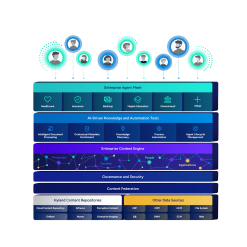What is document scanning and indexing software?
Remote work, the shift to paperless and the need for secure information management are fueling the importance for document scanning and indexing software.

Harness the power of a unified content, process and application intelligence platform to unlock the value of enterprise content.
Learn more
Automate your document-centric processes with AI-powered document capture, separation, classification, extraction and enrichment.
Learn about Hyland IDPIt's your unique digital evolution … but you don't have to face it alone. We understand the landscape of your industry and the unique needs of the people you serve.
 Overview of industries
Overview of industries
Countless teams and departments have transformed the way they work in accounting, HR, legal and more with Hyland solutions.
 Overview of departments
Overview of departments
We are committed to helping you maximize your technology investment so you can best serve your customers.
 Overview of services
Overview of services

Discover why Hyland is trusted by thousands of organizations worldwide.
Hear from our customers
Our exclusive partner programs combine our strengths with yours to create better experiences through content services.
Overview of partners
Find resources to power your organization's digital transformation.
Browse the resource center
Hyland connects your content and systems so you can forge stronger connections with the people who matter most.
Learn about HylandWith our modern, open and cloud-native platforms, you can build strong connections and keep evolving.
 Dig deeper
Dig deeper
Reading time minutes
Remote work, the shift to paperless and the need for secure information management are fueling the importance for document scanning and indexing software.

Document scanning and indexing capture information from paper documents and convert it into digital formats for ease of storage, search, retrieval and use.
Scanners currently have the capacity to scan thousands of pages of paper daily. These scanners transfer information from large troves of paper to digital, typically as PDF, TIFF or JPG files.
Scanning software with optical character recognition (OCR) capabilities processes the image files and extract the needed information. Indexing software then optimizes text for search by identifying and categorizing documents and applying search criteria.
Document scanning and indexing are necessary initial steps in an organization’s digital transformation plan. Scanning and indexing improve operations by:
Hardcopy documents must be stored in filing cabinets — either in an office space or off-site storage. In many ways, this practice incurs unnecessary expenses and risks for a business.
By document indexing and digitizing your paper trail, your organization fosters a more paperless ecosystem. This means that you can cut down on printing costs (ink, paper, printer maintenance, etc.) and even convert underutilized spaces into more office seating. Files that are electronically stored and backed up are not prone to fires, floods or other natural disasters that could affect physical paperwork.
Files that are scattered across disparate systems (email inboxes, employee desktops, etc.) or are still in hardcopy format will be challenging to access. This could result in confusion, bottlenecks and delays when it comes to decision-making.
Document indexing streamlines information accessibility throughout an organization. Employees can access documents based on field-based indexing (customer or company name, invoice number data, document type, etc.) without switching back and forth between systems. Indexed digital documents are simple to share, transfer, and view — so employees can execute business-critical decisions much more quickly.
When working with physical records, audit season can be complicated and time-consuming.
Today’s businesses must apply proper file retrieval and retention policies in the case of a lawsuit or court proceedings. OCR and other intelligent data capture tools serve as a precaution from a legal perspective. OCR minimizes the risks of error-prone manual entry and is a better method to accurately capture, access and share sensitive customer information.
Related articles
There are a variety of indexing methods available, and organizations can select these techniques based on the data that needs to be captured. Document indexing types include:
There are a variety of indexing methods available, and organizations can select these techniques based on the data that needs to be captured. Document indexing types include:
Full-text indexing involves searching for a word or phrase found within a document. After the whole document is scanned, each word is indexed along with its location. Users can then search anywhere within the text for specific keywords.
Field-based indexing refers to information located inside a database, otherwise known as “fields”. This indexing type allows users to find details that are unique to a page or document (date, time, vendor name, etc.) and can be tied back to metadata indexing.
Metadata is the type of data that contains information on other forms of data. This is generally used to depict the contents of the document. Metadata supplements a document with “tags” that contain relevant information that will simplify the search and retrieval process.
Document indexing is the process of assigning specific information to scanned documents. This works best through the application of document management software.
The process begins when a document is digitized and assigned relevant tags to make search and retrieval easier. Using OCR technology, the system will extract important information from the page once it has been scanned, save it as metadata and subsequently make full-text search possible. These tags can come in the form of information such as customer names, barcodes, dates and other forms of attribution.
Metadata and tags enable your software to pull up documents faster – instead of forcing it to analyze every single word in a document. For this to happen, all users with permission to create and edit documents must use standardized indexing methods.
An content services platform stores all content, regardless of where it originated. Direct integration with mobile scanning devices increases efficiency as batch scanning for quick capture and indexing makes information instantly retrievable for all appropriate users.
A content services platform can scan and index paper documents whilst ensuring: